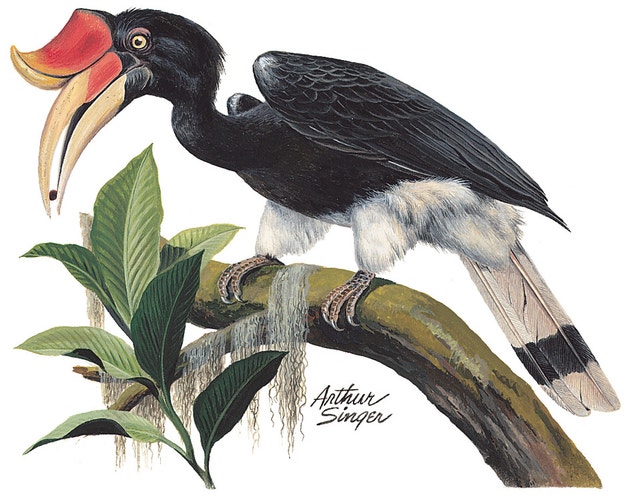Bird Poached for Its “Ivory”
October 13, 2015
Most everybody knows that elephants are hunted illegally for their ivory. But fewer people know about a type of bird whose ivory is three times as valuable. The bird is the helmeted hornbill of Malaysia and Indonesia, and its survival is being threatened by poaching.

The hornbill, shown in this illustration, is a medium-sized to large tropical bird with a huge, bright red and yellow bill. Its body is covered with black feathers on top and white feathers on its underside. The bird uses its clumsy-looking bill with great skill while eating. WORLD BOOK illustration By Arthur Singer
Elephant ivory comes from the animal’s tusk. The hornbill’s “ivory,” on the other hand, comes from a ridge called a casque on the bird’s upper bill. In most hornbill species, the casque is hollow. But the helmeted hornbill has a solid casque. Males use the heavy casque to batter one another in fights over mates, and both males and females use its weight to help bash into rotten trees, digging out insects to eat.
The casque is made up of a protein called keratin, also found in human fingernails and in animal horns, hooves, and claws. The bird continuously conditions the casque with the same oil used to preen its feathers. The result is a smooth, creamy texture and golden-yellow color that has been prized by carvers in China and Japan for centuries.
Among the local Dayak people, the huge black and white bird—with a wingspread of about 6 feet (2 meters)—is considered a sacred messenger of the gods. It also serves an important role in its rain forest habitat, helping to disperse nuts and seeds in its droppings. Laws protect the helmeted hornbill, but its numbers are threatened by habitat loss in addition to illegal hunting. One researcher estimates that about 6000 helmeted hornbills are killed illegally each year.


